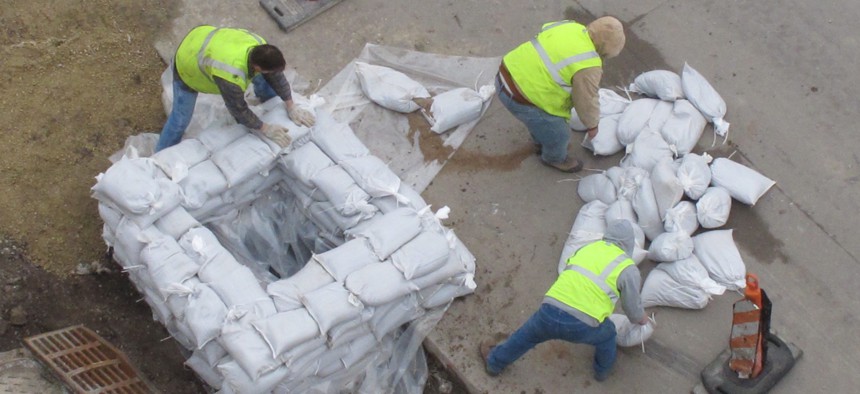When Rivers Come to 'Greet' a City

Workers fill up a pallet of sandbags outside of Modern Woodmen Park in Davenport, Iowa on Tuesday, March 22, 2011. AP Photo/Ryan J. Foley
An Iowa mayor and a D.C. city official reflect on flooding and other "resiliency" issues affecting their towns.
WASHINGTON — When Frank Klipsch, the mayor of Davenport, Iowa, visited here earlier this month, his city was dealing with flooding from the Mississippi River.
"Fortunately, it's well handled and I can be here," Klipsch told an audience that was gathered at the offices of a lobbying firm in Georgetown for a panel discussion on infrastructure "resiliency."
The mayor was in town representing not only his city, but also the Mississippi River Cities and Towns Initiative, a group he co-chairs, whose members include mayors from about 80 communities along the 2,350-mile river, in states stretching from Minnesota to Louisiana.
For the river cities and towns, the group offers a forum for cooperation about issues like flood control, water conservation, habitat restoration, and advocating for policy at the federal level.
"Getting all of us together and literally singing from the same song sheet is a very great step," Klipsch said.
Photos the city of Davenport posted online in the days leading up to the mayor's D.C. trip showed streets and other areas there underwater. The river crested on May 11 at about 17.4 feet, more than two feet above its 15-foot flood stage level.
But Klipsch emphasized that his town wasn't in deep trouble.
"We are one of the cities," he said, "that embraces the river."
"The river literally comes out of its banks in our nine miles of riverfront," the mayor added.
(A spokesperson for the city said by phone this week that there was not widespread damage to homes or businesses from this month's flooding, but could not confirm whether or not any properties near to the river might have had some damage.)
Located in eastern Iowa, on the border with Illinois, Davenport has about 103,000 residents.
It's the largest city in the "Quad Cities" region, an area in Iowa and Illinois that actually includes five cities. (The others are Moline, East Moline and Rock Island, Illinois, and Bettendorf, Iowa.)
The region has been hit by severe flooding in the past, such as the historic flood of 1993. But Davenport has taken steps in the years since that flood to prevent severe flood damage in the city.

Klipsch said Davenport's public works department is deft at using barriers and pumps to control water and also noted that the city relies on infrastructure like retention ponds.
He stressed the importance of not building up infrastructure that keeps flood water out of upriver towns, which results in forcing it down the river in greater volumes, threatening other communities.
"We haven't put up a flood wall and pushed our problems down to Arkansas, Louisiana and Missouri," Klipsch said.
There's been long-running debate in the city about whether to build such a structure.
Klipsch proudly referenced images that he said have appeared on national television of baseball games played in the city's riverfront stadium, Modern Woodmen Park, while it was surrounded by water.
The stadium, home of the Quad Cities River Bandits, a minor league ball club, has special features to keep it dry during flooding. Fans can cross over the water on a pedestrian bridge.
Less than a half-mile from the office building where Klipsch was speaking is the Potomac, one of two major rivers, along with the Anacostia, that cut through the landscape of the nation's capital.
One of the other people on hand that day was Kevin Bush, the District of Columbia's first-ever chief resilience officer.
He said he's noticed in his job that people often forget, or don't realize, that Washington, D.C., is a delta city and that the Potomac and the Anacostia are tidal rivers, which will be affected by sea level rise.
"I think people realize that we live on rivers," he said. "I don't think people realize that those rivers are coming to greet us."
Bush said D.C. takes a broad view of what it means for a place to be resilient, and that part of his job is considering how the city can handle not only threats like hurricanes and floods, but also everyday stressors like high housing costs and traffic congestion.
"How do they weaken our immune system?" he said. "How do they impact our ability to withstand those big shocks?"
The resilience chief is keen on multipurpose projects, such as "water gardens" that can serve as parks for most of the year and become stormwater infrastructure in the event of heavy rains or flooding.
And he suggested D.C. and other cities face a challenge when it comes to drawing connections for residents between the disparate issues that fall under the umbrella of resiliency.
"How do you reconcile both the fact that we have this immense amount of climate-related risk, with the fact that we need to prioritize increasing the supply of housing?" Bush said.
"If we don't effectively communicate both of those things," he added, "then we don't have a citizenry that's fully engaged in the long-term decision-making of the District."
Bill Lucia is a Senior Reporter for Government Executive's Route Fifty and is based in Washington, D.C.
NEXT STORY: Nebraska DOT Seeks Witty Traffic Messages






